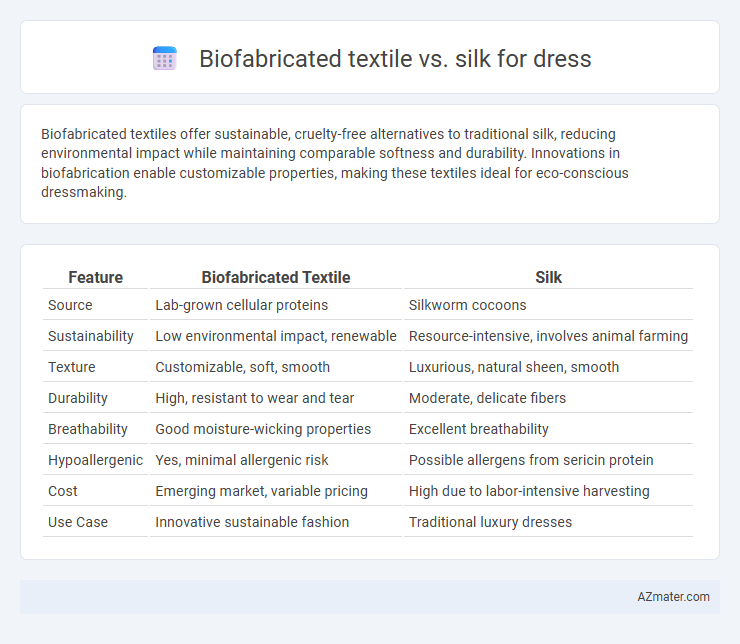Biofabricated textiles offer sustainable, cruelty-free alternatives to traditional silk, reducing environmental impact while maintaining comparable softness and durability. Innovations in biofabrication enable customizable properties, making these textiles ideal for eco-conscious dressmaking.
Table of Comparison
| Feature | Biofabricated Textile | Silk |
|---|---|---|
| Source | Lab-grown cellular proteins | Silkworm cocoons |
| Sustainability | Low environmental impact, renewable | Resource-intensive, involves animal farming |
| Texture | Customizable, soft, smooth | Luxurious, natural sheen, smooth |
| Durability | High, resistant to wear and tear | Moderate, delicate fibers |
| Breathability | Good moisture-wicking properties | Excellent breathability |
| Hypoallergenic | Yes, minimal allergenic risk | Possible allergens from sericin protein |
| Cost | Emerging market, variable pricing | High due to labor-intensive harvesting |
| Use Case | Innovative sustainable fashion | Traditional luxury dresses |
Introduction to Biofabricated Textiles and Silk
Biofabricated textiles are innovative materials created through biological processes, using microorganisms or cultured cells to produce sustainable fibers with reduced environmental impact. Silk, a natural protein fiber secreted by silkworms, has been prized for its smooth texture, strength, and luster in dressmaking for centuries. While silk offers traditional luxury and biodegradability, biofabricated textiles provide a cutting-edge alternative that addresses ethical concerns and resource limitations associated with conventional silk production.
The Science Behind Biofabricated Textiles
Biofabricated textiles are created through microbial fermentation processes, where genetically engineered microorganisms produce proteins that mimic natural silk's fibroin structure. This innovation allows precise control over molecular composition, resulting in materials with enhanced strength, elasticity, and sustainability compared to traditional silk derived from silkworm farming. The biofabrication method significantly reduces environmental impact by eliminating the need for land, water, and pesticides typically associated with silk production.
Silk: Nature’s Timeless Fabric
Silk, nature's timeless fabric, is prized for its luxurious softness, exceptional luster, and remarkable breathability, making it ideal for high-end dresses. Unlike biofabricated textiles, silk offers natural temperature regulation and a unique hand feel derived from its protein fiber structure produced by silkworms. The sustainability of silk depends on ethical sericulture practices, but its biodegradability and minimal chemical processing contribute to its enduring appeal in eco-conscious fashion.
Sustainability Comparison: Biofabrication vs. Traditional Silk
Biofabricated textiles use engineered microorganisms to produce fibers, significantly reducing water consumption and greenhouse gas emissions compared to traditional silk production, which relies on sericulture involving mulberry cultivation and silkworm farming. Biofabrication eliminates the need for pesticides and fertilizers, cutting down chemical runoff and soil degradation associated with mulberry farming. This innovative method also offers scalable production with lower land use, positioning biofabricated textiles as a more sustainable alternative to conventional silk in dressmaking.
Performance and Wearability Differences
Biofabricated textiles offer enhanced breathability and moisture-wicking properties compared to traditional silk, resulting in improved comfort during extended wear. While silk provides a natural sheen and exceptional softness, biofabricated materials often surpass silk in durability and resistance to environmental factors like UV exposure and microbial growth. The lightweight and stretchable nature of biofabricated textiles contribute to greater freedom of movement and reduced fabric fatigue, making them ideal for active or long-duration dress wear.
Aesthetic Qualities: Appearance, Texture, and Color
Biofabricated textiles offer a modern aesthetic with customizable textures and vibrant colors that can surpass the natural variability of silk. Unlike silk's smooth, lustrous surface and subtle sheen, biofabricated fabrics can mimic or enhance tactile qualities, providing unique finishes from matte to glossy. Color retention in biofabricated textiles is often superior due to controlled production processes, allowing for consistently rich and diverse palettes ideal for dressmaking.
Ethical Considerations: Animal Welfare and Eco-Impact
Biofabricated textiles offer a sustainable alternative to traditional silk by eliminating the need for silkworm cultivation, significantly reducing animal welfare concerns associated with the killing of silkworms during silk harvesting. The production of biofabricated textiles involves fewer greenhouse gas emissions and less water consumption compared to conventional silk farming, resulting in a lower ecological footprint. Ethical considerations in fashion increasingly favor biofabricated textiles due to their cruelty-free nature and potential to mitigate environmental degradation linked to sericulture.
Technological Advancements in Textile Manufacturing
Biofabricated textiles leverage cutting-edge biotechnology and synthetic biology to create sustainable, lab-grown fibers mimicking or surpassing silk's natural properties such as strength, sheen, and breathability. Advanced biofabrication processes reduce environmental impact by eliminating the need for silkworm farming, utilizing microbial fermentation or cellular agriculture to produce proteins that form the textile's base material. These technological advancements enable customizable textile properties and scalable production, positioning biofabricated fabrics as innovative alternatives to traditional silk in high-performance dressmaking.
Cost Analysis: Production and Market Pricing
Biofabricated textiles generally incur higher production costs due to advanced biotechnological processes and the need for specialized equipment, whereas silk production benefits from established sericulture methods with economies of scale. Market pricing for biofabricated textiles tends to be premium, reflecting innovation and sustainability factors, while silk remains competitively priced as a traditional luxury fiber. Cost efficiency in silk markets contrasts with the rising investment in biofabricated textiles, which aims to reduce expenses over time through scaling and technological advancements.
Future Trends in Dressmaking Materials
Biofabricated textiles are emerging as sustainable and cruelty-free alternatives to traditional silk, offering customizable properties such as enhanced breathability and durability for future dressmaking applications. Advances in biotechnology enable large-scale production of biofabricated fibers with reduced environmental impact, supporting circular fashion initiatives and lowering the carbon footprint compared to conventional silk farming. Innovations in biofabrication techniques promise integration of smart functionalities, including moisture-wicking and antimicrobial features, positioning biofabricated textiles at the forefront of next-generation dress materials.

Infographic: Biofabricated textile vs Silk for Dress
 azmater.com
azmater.com